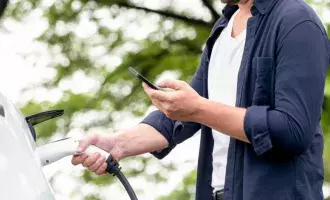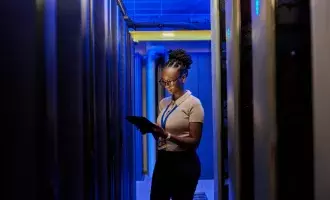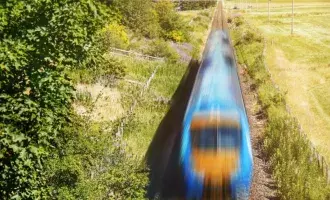If we’re to achieve net zero targets, as a matter of urgency we must accelerate the decarbonisation of transport. This can best be achieved by reducing the number of private vehicles on our roads – but that means making public transport convenient, easy to use and affordable.
We recently conducted an independent survey to better understand the public’s awareness and perceptions of net zero. The findings revealed some surprising insights into the public’s understanding of net zero, what it involves and who’s responsible for making the goal a reality. The report also suggests several purposeful solutions that can help to drive progress and behavioural changes in communities.
The transport sector is the country’s largest producer of carbon and greenhouse gas emissions, responsible for 24% of the UK’s total emissions in 2020 – despite commuting that year being at a record low due to the Covid-19 pandemic. Ninety-one percent of domestic transport emissions come from road vehicles, whereas the rail network contributes only 1.4%.
The perceived responsibility gap
According to our findings, the responsibility of driving net zero and implementing carbon neutrality measures is not clearly articulated in the public domain. The vast majority (89%) of respondents attribute accountability to central government, versus only 57% to transport providers and 56% to local government. Fewer than half of those aged 18 to 24 recognised the role that transport providers play in delivering this goal.
This gap in perceptions suggests that transport providers and local authorities need to raise their profiles on green matters if they want the public to participate in achieving our common end goal. It’s evident that there is a tremendous opportunity – and responsibility – for transport providers to influence the attitudes, expectations and actions of the people who use their services every day.
Cost-effective, convenient and carbon-neutral services
The UK is in the grip of a cost of living crisis unseen in living memory; the number of struggling families has doubled over the last year. If the public transport infrastructure is to survive, it must adapt its pricing practices.
A pilot scheme launched in Cornwall in April 2022, “Make Big Savings by Bus” introduced technology that allows passengers using contactless payments to “tap on and tap off” – capping their payments to no more than £5 a day or £20 a week, regardless of how many journeys they make. In September 2022, the then-Transport Secretary Grant Shapps announced that £60 million would be available from January to March 2023 to help bus operators to cap single adult fares at £2 per journey. We hope this initiative goes ahead as planned despite the current political uncertainty in the transport sector. The results of the latter scheme remain to be seen, but Simon Goff, Managing Director for First South West, said that the Cornwall scheme has encouraged people to take more journeys by bus.
The most significant scheme of this kind was flighted in Germany in the summer of 2022. The coalition government introduced a €9 monthly ticket permitting travellers to take unlimited train, bus and tram journeys. The project cost €2.5bn in public funding, but in that time 52 million tickets were sold, 17% of users switched to public transport and people took 42% more rail trips over 30km than in the same pre-pandemic period. The German Transport Association calculates that this led to a reduction of 1.8m tonnes in CO2 emissions. While the scheme ended in early September, it has been replaced by the Deutschlandticket, which offers passengers the same entitlements for €49 per month (about €1.60 per day). The German Transport Minister said that the move was aimed at cutting emissions and helping people to cope with the cost of living crisis.
Transport providers should also consider following in the aviation industry’s footsteps by providing dynamic ticket payment options that support the new hybrid way of working. With millions of people working at least partly from home, peak ticket pricing for rush hour could become a thing of the past. Dynamic pricing helps spread the demand for travel throughout the day by changing the ticket price in real time depending on how busy the train or bus is. For people in many industries post-pandemic, commuting is no longer viewed as a necessity and time spent in the office does not need to be nine-to-five for everyone.
Reconfiguring transport access and timetables
Better collaboration between disparate transport providers will make public transport more appealing to those it’s meant to serve. Adapting local bus timetables to synchronise them with train schedules – for example – will encourage more people to opt for a bus home from the station over a car. Not only will this cut emissions in local council areas, but it’ll also reduce traffic congestion in town centres, ease the demand for parking and result in cleaner air.
Technology can facilitate this joined-up approach for national travel too. Navigating public transport in unfamiliar cities shouldn’t require passengers to download multiple apps or visit a separate website for each. If used correctly, collaborative technology could integrate travel information from around the country, enabling travellers to plan a journey from anywhere in the UK to a specific address via one single app.
Town planning that supports low carbon transport
Traffic infrastructure supporting low-carbon transport – such as bus and cycle lanes, which make those modes of travel faster and safer – has been shown to encourage uptake. Forty percent of Britons surveyed by Halfords said they would cycle more if their safety was assured by dedicated cycle lanes.
A controversial approach to behaviour change is being flighted by Oxford City Council. Traffic filters are to be introduced “to reduce unnecessary journeys by private vehicles and make walking, cycling, public and shared transport the natural first choice”. These filters require private vehicles going into parts of the city to display permits while allowing other modes of transport to enter. The purpose is to encourage people to consider taking other, more sustainable modes of transport, thus driving behavioural change.
Taking unified action
There’s an enormous opportunity for engaging the public on the topic of sustainability and reducing the current impact of buildings and transport on carbon emissions. To achieve this, decision-makers in government, local authorities and transport providers need to unify their efforts to help bridge the gaps between the public’s sentiment on climate change and their ability to take decisive action. All stakeholders need to up their communications game and explain in simple language why public transport is so critical in achieving net zero and ensure that their offering is affordable, appealing and relevant to the public’s needs – in order to accelerate behavioural change.
To understand how you can drive progress and sustainable behavioural changes in your communities, download our latest report: Achieving net zero.

Phil Evans
Market Development Director, Transport
As a domain expert, Phil provides business development, sales and strategy expertise to the energy and transport sectors specialising in new technologies, innovation and digital transformation. His key focus is on decarbonisation, particularly in relation to smart grids, energy storage, smart cities and the link to transportation electrification strategies, as well as emerging mobility services such as mobility-as-a-service.







